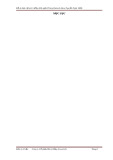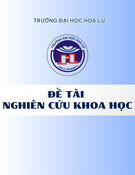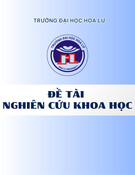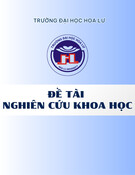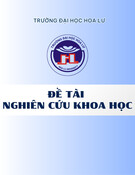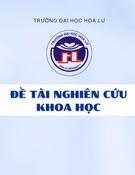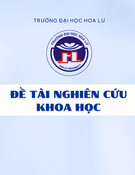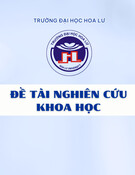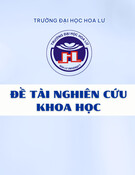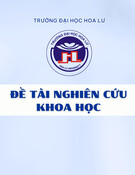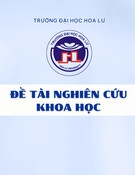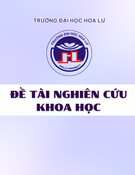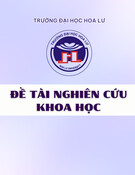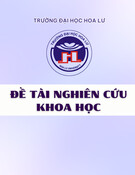
BioMed Central
Page 1 of 9
(page number not for citation purposes)
Journal of Immune Based Therapies
and Vaccines
Open Access
Original research
Tumor–associated antigens identified by mRNA expression
profiling as tumor rejection epitopes
Marie Louise Andersen1, Morten Ruhwald1, Mette Thorn1,
Anders Elm Pedersen1, Susanne Mathiassen1, Soren Buus2 and
Mogens H Claesson*1
Address: 1Department of Medical Anatomy, University of Copenhagen, Copenhagen, Denmark and 2Institute of Medical Microbiology and
Immunology, University of Copenhagen. Copenhagen, Denmark
Email: Marie Louise Andersen - bodil_marielouise@wanadoo.dk; Morten Ruhwald - mruhwald@hotmail.com;
Mette Thorn - mette_thorn@hotmail.com; Anders Elm Pedersen - elmpedersen@mai.ku.dk; Susanne Mathiassen - susanne@expmed.ku.dk;
Soren Buus - s.buus@immi.ku.dk; Mogens H Claesson* - M.H.Claesson@mai.ku.dk
* Corresponding author
Tumor associated antigensmRNA microassayPeptide p53Vaccination
Abstract
Thirteen H-2b-binding peptides derived from six potentially overexpressed proteins in p53-/-
thymoma (SM7) cells were studied for immunogenecity and vaccine-induced prevention of tumor
growth in mice inoculated with SM7 tumor cells. Six of the peptides generated specific CTL
responses after immunization, but only two of these peptides (RAD23–31 and RAD24–31) were
capable of generating a weak vaccination-induced protection against adoptive tumor growth. SM7
inoculated mice treated with a blocking antibody against the inhibitory T cell signal transducing
molecule CTLA4 appeared to delay tumor take, suggesting that SM7 thymoma cells are recognized
by the adaptive immune system of the host. However, prophylactic vaccination with RAD23–31 and
RAD24–31 peptides combined with anti-CTLA4 Ab treatment and did not improve tumor
resistance. Our data would indicate that vaccination with immunogenic peptides derived from
potentially overexpressed tumor proteins, as identified by mRNA expression profiling of p53-/-
thymoma cells, at best results in a weak tumor protection thus questioning this way of detection
of new tumor rejection epitopes.
Introduction
Identification of tumor associated antigens (TAA) recog-
nized by CD8+ T cells and the corresponding major histo-
compatibility complex class I (MHC-I) restricted epitopes
has led to peptide-based vaccination approaches in exper-
imental animals as well as in clinical settings [1–5]. Since
many MHC-I restricted TAA so far identified represent
peptides derived from self proteins, it is not surprising
that most of these TAA are relatively weak immunogens
and that reports demonstrating tumor regression after
peptide vaccination in clinical trials are sparse. Occasional
marked clinical regressions of melanoma have been ob-
served after peptide vaccination [5–7].
To search for new TAA, we have recently used mRNA pro-
filing to analyze a panel of spontaneously arising thymo-
mas in p53-/- mice and identified a number of upregulated
mRNAs [8]. Immunizing with a pool of six peptides rep-
resenting upregulated RAD50, a part of a DNA regulatory
protein complex [9], we obtained partially protection
Published: 29 January 2003
Journal of Immune Based Therapies and Vaccines 2003, 1:1
Received: 13 November 2002
Accepted: 29 January 2003
This article is available from: http://www.JIBTherapies.com/content/1/1/1
© 2003 Andersen et al; licensee BioMed Central Ltd. This is an Open Access article: verbatim copying and redistribution of this article are permitted in all
media for any purpose, provided this notice is preserved along with the article's original URL.

Journal of Immune Based Therapies and Vaccines 2003, 1http://www.JIBTherapies.com/content/1/1/1
Page 2 of 9
(page number not for citation purposes)
against the take and growth of inoculated tumor cells
overexpressing RAD50 mRNA. This finding suggested to
us that tumor rejecting epitopes can be identified by
mRNA expression profiling.
In the present work we have focussed on the CTL generat-
ing effect after immunization with individual RAD50 de-
rived peptides and with H2b-binding peptides derived
from other proteins encoded by differentially upregulated
mRNAs [8]. By immunization, half of the peptides, in-
cluding two of the RAD50-derived peptides, were found
to induce significant peptide specific CTL responses. How-
ever, none of these peptides were capable of eliciting CTL
responses against the thymoma cells from which they
were derived. Mice vaccinated with the two immunogenic
RAD50 peptides were weakly protected against tumor
take, whereas vaccination with a pool of the four immu-
nogenic thymoma associated peptides derived from other,
potentially upregulated thymoma proteins, did not influ-
ence tumor take. Treatment with a blocking antibody
against the cytotoxic T lymphocyte antigen CTLA4 [10]
has been shown previously to enhance the effect of tumor
rejection in mice vaccinated with irradiated tumor cells
[11,12]. However, this treatment did not increase peptide
vaccine-induced protection against tumor take, suggesting
the tumor associated peptides, characterized in the
present study, represent at best very weak tumor rejection
epitopes.
Results
Generation of CTL responses
Individual RAD50 derived peptides [8] (see Table 1), with
a binding affinity (KD) for H-2b at 12–280 nM [13], were
injected subcutaneously in Freunds Incomplete Adjuvant
(FIA). Splenocytes were recovered 10 days after immuni-
zation and challenged in vitro for 5 days with irradiated
syngenic spleen cells pulsed with specific peptide (see Ma-
terials and Methods). CTL responses were measured
against RMA-.S and SM7 target cells pulsed with specific
peptide or mock peptide. Mean data for groups of three
immunized mice are shown in Figure 1. Only two of the
RAD50 peptides, RAD23–31 and RAD24–31, with KD values
of 280 and 70 NM respectively [13], induced a CTL re-
sponse (Fig. 1A) and only immunization with the RAD23–
31 peptide induced killing of RAD24–31-pulsed SM7 cells
(Fig. 1B), whereas unpulsed SM7 cells were not killed by
any of the peptide specific CTLs (Fig. 1C). Experiments
(not included) showed that CTLs raised against the
RAD23–31 peptide killed RAD24–31 pulsed RMA-S cells to
the same extend as RAD23–31 pulsed cells whereas CTLs
generated against the RAD24–31 peptide killed the RAD23–
31 pulsed RMA-S with only half the efficiency of RAD24–31
peptide pulsed cells. These data suggest that some of the
CTLs generated against the RAD23–31 peptide separately
recognize the C-terminal glutamine in the RAD23–31 pep-
tide.
In separate experiments mice were immunized with a
mixture of non-immunogenic and immunogenic RAD50
peptides. The data (not included) indicated that CTL
development against the two admixed immunogenic
RAD50 peptides was not impaired by the admixed non-
immunogenic peptides indicating that these peptides do
not compete out the MHC-I binding of the immunogenic
peptides on the surface of APCs during the process of
immunization.
Individual peptides derived from six potentially upregu-
lated SM7 proteins not related to RAD50 (Table 1) [8],
with KD values for H-2b binding at 2–9500 nM [13], were
used for immunization as described above. Fig. 2A shows
that immunization with 4 of 8 peptides derived from
these proteins induced significant peptide specific CTL
generation. The four immunogen peptides have KD values
of 2–155 [13]. Immunization with peptide CatB 47–55
also induced killing og CatB47–55 pulsed SM7 cells where-
as unpulsed thymoma cells were not killed by the peptide
specific CTLs (Fig. 2C). The resistance of peptide-pulsed
SM7 cells to killing by most peptide specific CTLs does not
reflect lack of H-2b expression, as documented by FACS
analysis (data not included).
Vaccination and anti-CTLA4 antibody-induced protection
against tumor take
Groups of 7–8 mice were vaccinationated three times with
a pool of the six RAD50 peptides or a mixture of the two
immunogenic RAD23–31 and RAD24–31 peptides. The
RAD50 peptides were mixed with equal amounts of FIA
and a helper peptide, TPPAYRPPNAPIL [14] was included.
Control mice received FIA and helper peptide only. Fig. 3
shows the pooled survival curves for two separate experi-
ments. A significant protection against tumor take was ob-
tained in mice vaccinated with a mixture of RAD23–31 and
RAD24–31 peptides (p < 0.03). In disagreement with our
previous study [8], vaccination with a mixture of the six
RAD50 peptides did not offer any protection in these ex-
periments (data not shown). Two of five vaccine protected
mice in Fig. 3 were rechallenge with 106 tumor cells 3
months after the primary tumor challenge. Two of the
mice developed progressing tumors, suggesting low im-
munological memory for tumor rejection antigens (data
not included). Fig. 4 shows data from one of two experi-
ments with mice immunized with a mixture of the 4 im-
munogenic peptides depicted in Fig. 2. These peptides are
derived from four potentially upregulated SM-7 proteins
not related to the RAD50 protein (Table 1). No evidence
of protection was obtained after immunization with this
serie of peptides in the two separate, but identical vaccina-
tion series.

Journal of Immune Based Therapies and Vaccines 2003, 1http://www.JIBTherapies.com/content/1/1/1
Page 3 of 9
(page number not for citation purposes)
Figure 1
CTL development in vivo against SM7-derived RAD50 peptides. Groups of three mice were immunized once subcutaneously
with individual peptides including a helper peptide. Splenocytes were peptide challenged ex vivo at day 10 and assayed for CTL
activity five days later. A, Generation of CTLs against RAD50 peptides. B, CTL reactivity against SM7 thymoma cells pulsed
with the RAD50 peptides. C, CTL reactivity against non-pulsed SM7 thyoma cells (see Table 1 for peptide name, sequence and
MHC-I binding affinity).
A
-10
0
10
20
30
40
50
60
70
80
90
100
100:1 75:1 50:1 25:1
Effector:Target ratio (peptidepulsed RMA-S cells)
Specific lysis (%)
RAD50-391-399 RAD50-1257-1265
RAD50-603-611 RAD50-24-31
RAD50-23-31 RAD50-1131-1138
MOCK-peptide
B
-10
0
10
20
30
40
50
60
70
80
90
100
100:1 75:1 50:1 25:1
Effector:Target ratio (peptide-pulsed SM7 cells)
Specific lysis (%)
RAD50-391-399 RAD50-1257-1265
RAD50-603-611 RAD50-24-31
RAD50-23-31 RAD50-1131-1138
MOCK-peptide
C
-10
0
10
20
30
40
50
60
70
80
90
100
100:1 75:1 50:1 25:1
Effector:Target ratio (SM7 cells treated 24 hours with IFN-J)
Specific lysis (%)
RAD50-391-399 RAD50-1257-1265
RAD50-603-611 RAD50-24-31
RAD50-23-31 RAD50-1131-1138
MOCK-peptide

Journal of Immune Based Therapies and Vaccines 2003, 1http://www.JIBTherapies.com/content/1/1/1
Page 4 of 9
(page number not for citation purposes)
The data in Fig. 3 and Fig. 4 illustrate that vaccination with
the chosen tumor-derived immunogenic peptides results
in a very marginal protection against tumor take. In order
to investigate whether the growth of SM7 thymoma cells
in naïve is controlled by the adaptive immune system,
mice challenged with 1 mio. SM7 cells were treated with a
CTLA4-blocking antibody. The data in Fig. 5 indicate that
this treatment influenced tumor take. Thus antibody treat-
ed mice tended to delay tumor take after challenge with
106 SM7 cells compared with untreated control mice, the
two curves being statistically different at 65 days of surviv-
al (p < 0.04). However, neither RAD23–31 and RAD24–31
peptide vaccination alone nor combined with anti-CTLA4
Ab treatment did delay tumor take in this experiment.
Discussion
Vaccination with a mixture of two immunogenic RAD50-
peptides, RAD23–31 and RAD24–31, detected among six H-
2b binding ones, had some protective capacity in mice
against tumor take following a subcutaneous inoculation
of 106 SM7 thymoma cells. Memory for tumor rejection
antigens did develop in only 3 of 5 of the tumor-rejecting
mice as evidenced by the absence of tumor take after a sec-
ond tumor challenge. Vaccination with a mixture of four
immunogenic peptides derived from other potentially up-
regulated SM7 proteins did not induce tumor protection.
The present and previous experiments [8] might suggest
that differences in mRNA expression profiles could be an
efficient way to search for tumor rejection epitopes. How-
ever, the best interpretation of the present data is that such
epitopes are weakly and inconsistently expressed by the
tumor cells from which the peptides are derived. This in-
terpretation is based on following reasoning:
Firstly, we were unable to reproduce our previous obser-
vations of prolonged survival and decreased tumor take in
mice after immunization with the pool of six RAD50 pep-
tides [8]. This inconsistency might reflect differences
between the tumor cells used for challenge in our former
and present study, respectively. Thus, the SM7 tumor cells
used in [8] were derived from a freshly obtained solid tu-
mor subcultured for 8–10 passages in vitro, whereas the
SM7 cells of the present study was derived from a frozen
stock of the first in vivo passage of SM7 cells subcultured
for 3–5 passages in vitro.
Secondly, partly overlapping CTL activities were generated
after peptide vaccination with the two protective closely
related immunogenic RAD50 peptides (see Table 1), but
these CTLs were unable to kill SM7 tumor cells in vitro.
This observation might suggest either that the rejection
epitopes are not identical with the RAD50 peptides used
for vaccination or that RAD50 epitopes are being ex-
pressed in vivo only. Thus at best, RAD50-derived
epitopes are only weakly and inconsistently expressed. A
similar inconcistency between lack of killing of tumor
cells in vitro and protection against tumor take was report-
ed recently after immunization with wild-type p53 ex-
pressing vaccinia virus [15]. Protection in this latter work
was shown to involve both CD4, CD8 and NK cell
responses.
Thirdly, CTLA4 blockade, which suppresses inhibitory
costimulatory signals in responder T cells [10], tended to
delay the rejection of inoculated SM7 tumor cells in naïve
mice (Fig. 5). However, CTLA4 blockage failed to improve
survival in RAD23–31 and RAD24–31 vaccinated mice,
although a protective collaboration between vaccination
Table 1: Potentially overexpressed p53-/- SM7 thymoma proteins as analyzed by mRNA expression profiling including predicted,
sequenced and assayed protein-derived H2b binding peptidesa.
Protein name Peptide sequence Peptide name KD nMb
RAD50 RQIKNFHEL RAD50 391–399 45
RAD50 SQQRNFQLL RAD50 603–611 12
RAD50 SAEQNKNHI RAD50 1257–1265 13
RAD50 IISFFSPL RAD50 24–31 70
RAD50 QIISFFSPL RA50 23–31 280
RAD50 AIMKFHSM RAD50 1131–1139 36
Endonuclease* YAYTFWTYM Encl261–269 80
RAD23 KALGFPESL RAD23 328–336 2950
PMS2 LGQFNLGFI PMS2 676–684 410
PMS2* FGPQDIDEL PMS2 775–783 2
Cathepsin B* FYNVDIDYL CatB 47–55 155
Translin VSEIFVEL Translin 3–10 560
Protease-nexin 1* WHEPFFIL Pn1 3–10 ND
Protease-nexin 1 VHSQFNSL Pn1 18–25 9500
afor details see reference no. [8]bdata are from ref. [13]. *Immunogenic peptides, see Figs 1,2.

Journal of Immune Based Therapies and Vaccines 2003, 1http://www.JIBTherapies.com/content/1/1/1
Page 5 of 9
(page number not for citation purposes)
Figure 2
CTL development in vivo against SM7-derived peptides not related to RAD50. Vaccinations as described in text Fig. 1. A, Gen-
eration of CTLs against SM7 peptides. B, CTL reactivity SM7 thymoma cells pulsed with SM7 peptides. C, CTL reactivity against
non-pulsed SM7 thymoma cells.
A
-10
0
10
20
30
40
50
60
70
80
90
100
100:1 75:1 50:1 25:1
Effector:Target ratio (peptide-pulsed RMA-S cells)
Specific lysis (%)
Encl-261-269 RAD23-328-336
PMS2-676-684 PMS2-775-783
Translin-3-10 CatB-47-55
MOCK-peptide Pn1-3-10
B
-10
0
10
20
30
40
50
60
70
80
90
100
100:1 75:1 50:1 25:1
Effector:Target ratio (peptide-pulsed SM7 cells)
Specific lysis (%)
Encl-261-269 RAD23-328-336
PMS2-676-684 PMS2-775-783
Translin-3-10 CatB-47-55
MOCK-peptide Pn1-3-10
C
-10
0
10
20
30
40
50
60
70
80
90
100
100:1 75:1 50:1 25:1
Effector:Target ratio (SM7 cells treated 24 hours with IFN-J)
Specific lysis (%)
Encl-261-269 RAD23-328-336
PMS2-676-684 PMS2-775-783
Translin-3-10 CatB-47-55
MOCK-peptide Pn1-3-10

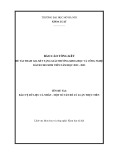
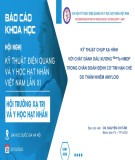

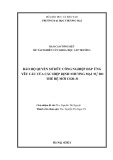
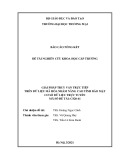
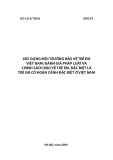

![Vaccine và ứng dụng: Bài tiểu luận [chuẩn SEO]](https://cdn.tailieu.vn/images/document/thumbnail/2016/20160519/3008140018/135x160/652005293.jpg)
